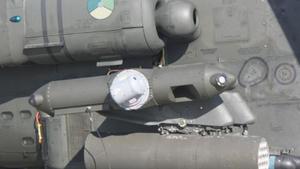Lasers will protect helicopters from heat-seeking missiles
A Michigan company using off-the-shelf telecommunications fiber optics to develop rugged and portable mid-infrared supercontinuum lasers that could blind heat-seeking weapons from a distance of 1.8 miles away; the technology will be used to protect combat helicopters from heat-seeking missiles

Northrop-Grumman's Directional Infrared Countermeasure mounted on an AH-64D // Source: gizmag.com
Protecting combat helicopters from heat-seeking missiles is the goal of new laser technology developed at the University of Michigan and spin out company, Ann Arbor-based Omni Sciences.
“Battlefield terrain in places like Afghanistan and Iraq can be so rough that our troops have often had to rely on helicopters, and they can be easy targets for enemies with shoulder-launched missiles,” said Mohammed Islam, a professor in the Department of Electrical Engineering and Computer Science. “Our lasers give off a signal that’s like throwing sand in the eyes of the missile.”
The Engineer reports that using off-the-shelf telecommunications fiber optics, Islam is developing rugged and portable “mid-infrared supercontinuum lasers” that could blind heat-seeking weapons from a distance of 1.8 miles away.
The technology is being commercialized through Islam’s company, Omni Sciences, which has recently received $1 million in grants from the U.S. Army and the Defense Advanced Research Projects Agency (DARPA) to build a second-generation prototype. The army grant amounts to $730,000 and the DARPA funding is worth $300,000.
The lasers are promising for helicopter protection because their design can withstand helicopter flight and their mid-infrared supercontinuum mode can jam missile sensors.
Most lasers emit light of just one wavelength but supercontinuum lasers give off a focused beam packed with light from a broader range of wavelengths. Visible-wavelength supercontinuum lasers, for example, discharge tight columns that appear white because they contain light from across the visible spectrum.
Islam’s mid-infrared supercontinuum laser does the equivalent, but it is said to be the first to operate in longer infrared wavelengths that humans can not see, but can feel as heat. Heat-seeking missiles are designed to home in on the infrared radiation that the helicopter engine emits.
Because this new laser emits such a broad spectrum of infrared light, it can effectively mimic the engine’s electromagnetic signature and confuse any incoming weapons, Islam said.
This new light source has many military applications, Islam said, but it is especially well suited for helicopters.
“The laser-based infrared countermeasures in use now for some aircraft have 84 pieces of moving optics. They couldn’t withstand the shake, rattle and roll of helicopters,” Islam said. “We’ve used good, old-fashioned stuff from your telephone network to build a laser that has no moving parts.”
